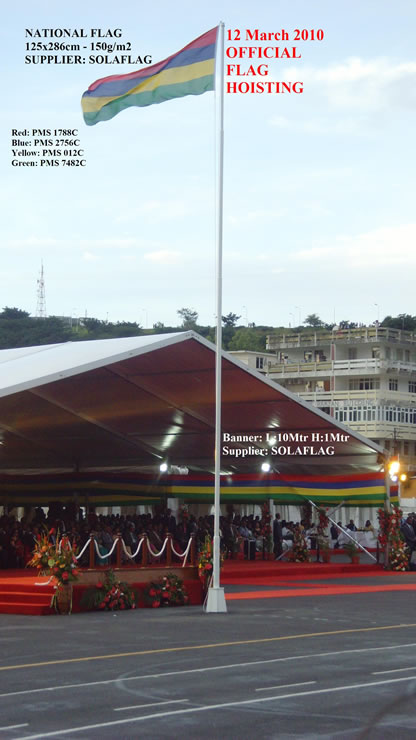
Fly the flag from sunrise to sunset on a clear day. National flags should not be flown in bad weather (e.g., during cyclones). If a national flag is flown at night it should be brightly illuminated. Hoist (raise) the flag in a brisk fashion and lower it in a dignified, ceremonious way.
Flags flown at half-mast should be hoisted to full mast then lowered slowly and ceremoniously to half-mast.
Never let a national flag touch the ground, water or the floor.
When flags of multiple countries are flown in the same place, they must all be displayed as equals. They should each be flown on individual flagpoles each of the same size. All of the flags must be the same size and no flag can be bigger or smaller than another flag. National flags of multiple countries should be arranged in alphabetical order.
When two flags are displayed (in a line); the national flag should appear on the left side when viewed by an observer.
When three flags are displayed in a line the national flag should be in the middle (i.e. the second flag).
When four flags are displayed in a line, the national flag should be the first flag on the left when viewed by an observer.
When a flag is no longer in good condition (e.g., if it is torn, ripped or badly soiled) it should not be raised or displayed. It should be disposed of in a dignified way (such as a private burning).
Flag adopted upon independence, on 9 January 1968.
Symbolism
The flag was designed by the College of Arms in Britain prior to independence.
- Red reflects independence
- Blue for the color of the Indian Ocean
- Yellow symbolizes a bright future
- Green represents the lush vegetation of the island.
The flag was actually registered at the College of Arms on 9 January 1968, it was granted by Royal Warrant and the flag first officially hoisted on 12 March 1968 (the day of independence).
The RED stripe represents the struggle for freedom and independence, while
BLUE stands for the Indian Ocean.
The YELLOW stripe symbolizes the new light of independence, and
The GREEN represents agriculture together with the yearlong colour of a lush country.
